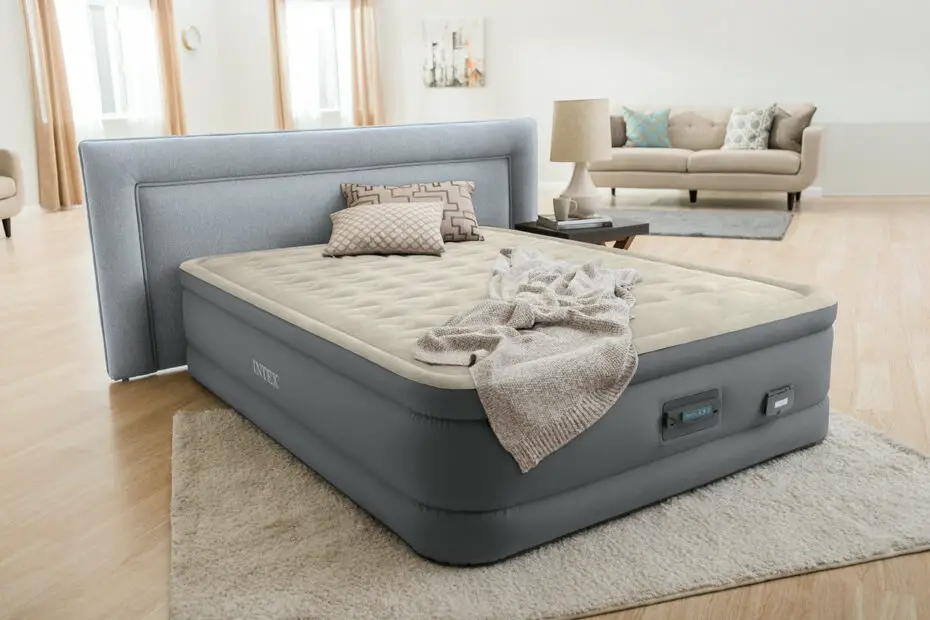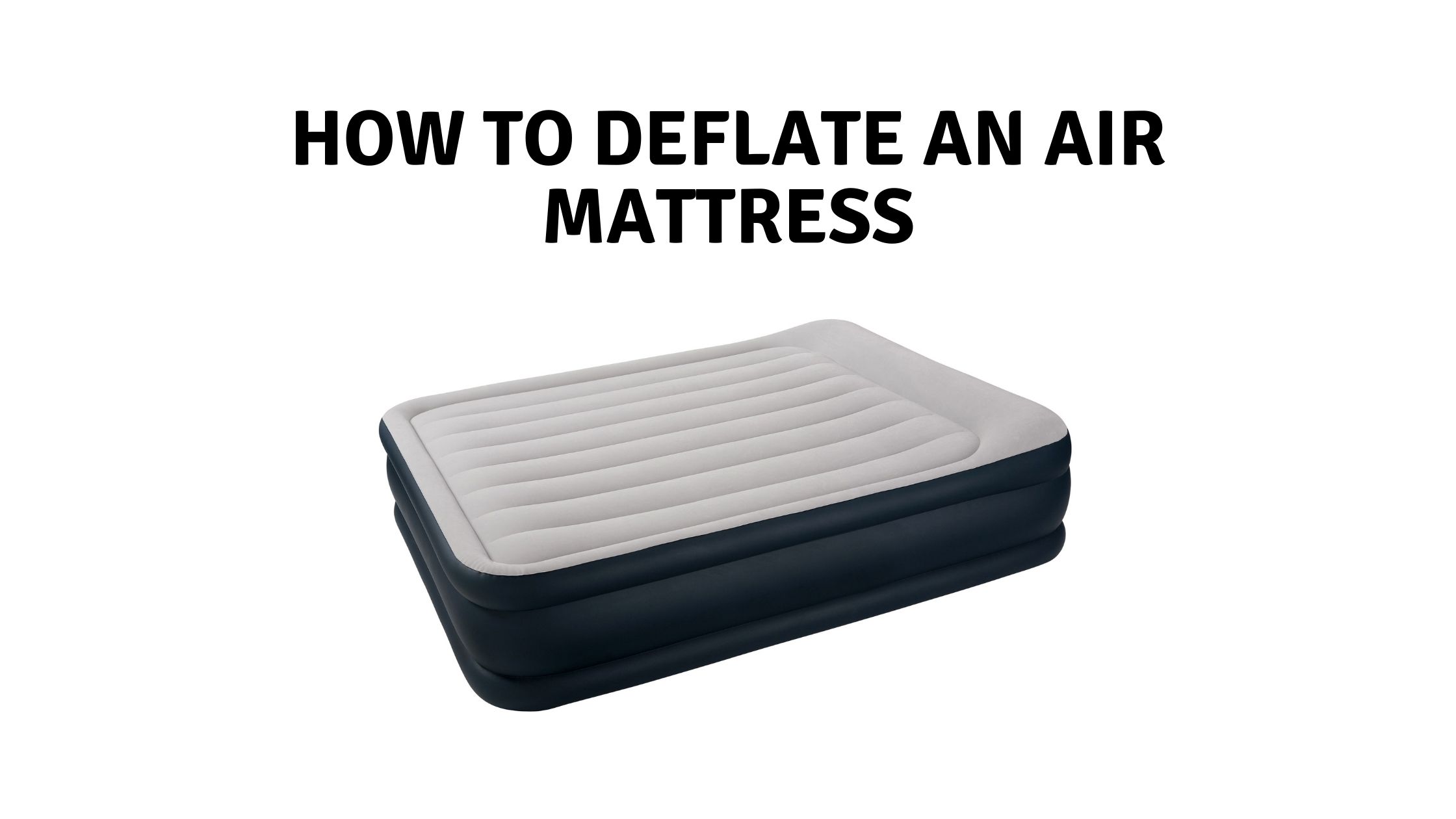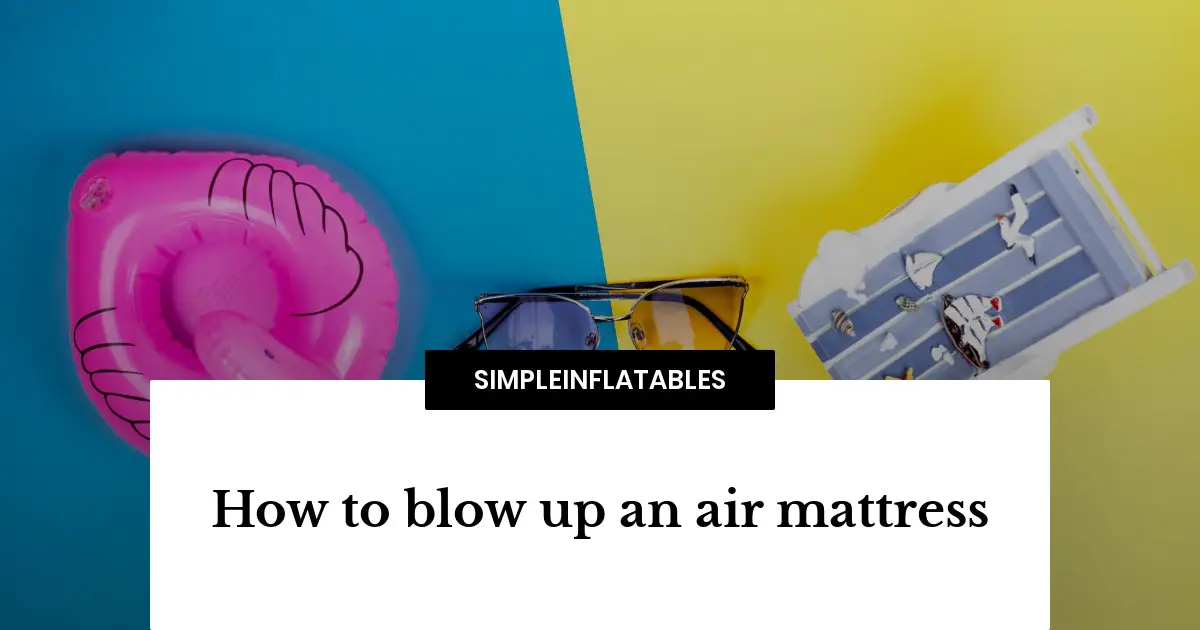Are you wrestling with your Intex air mattress, trying to get it deflated and stowed away as swiftly and effortlessly as possible? Perhaps you’re preparing for guests to leave after a cozy sleepover, or maybe you’re the one packing up after a rejuvenating camping trip. Whatever the case, the task at hand doesn’t have to be a struggle filled with huffing, puffing, and unnecessary delays. Welcome to our “Step-by-Step Guide: How to Deflate an Intex Air Mattress Quickly and Easily.”
This guide is crafted to transform what seems to be a cumbersome chore into a simple, hassle-free process. We’ll walk you through the secrets to mastering the art of air mattress deflation, ensuring you can move on with your day without being held up by a stubbornly inflated sleep surface. Say goodbye to the puzzling scenarios of half-deflated beds or the bewildering sight of an air mattress that seems to inflate on its own as you attempt to pack it away. Let’s deflate that mattress with efficiency and ease!
how to deflate intex air mattress: Quick And Easy Steps
Deflating an Intex air mattress properly and quickly requires a systematic approach. Given that Intex is a notable brand in the air mattress sector, they’ve designed their mattresses with user convenience in mind. Here are some quick and easy steps tailored to the nuances of Intex air mattresses:
- 1. Make sure there are no sharp or pointed objects nearby that could inadvertently puncture the mattress.
- 2. Intex air mattresses typically come with a 2-in-1 valve system. This includes a wide opening for fast inflation/deflation and a smaller one for adjustments. The valve cap often has a double-sealed design.
- 3. Unscrew or unlock the cap of the broader section of the valve. This will enable rapid air release. Most Intex air mattresses have a push-in tab that, when depressed, allows for swift deflation.
- 4. As air begins to flow out, you can expedite the process by gently pressing or rolling the mattress, starting from the end opposite the valve and moving towards it. This helps in pushing out the air more efficiently.
- 5. If the mattress is elevated, lifting it from the end away from the valve can guide the air toward the valve, using gravity to aid in deflation.
- 6. Once most of the air has been let out, fold the mattress in half and roll or press it tightly from the end farthest from the valve towards the valve. This ensures almost all the air is expelled.
- 7. As soon as you’re confident the mattress is thoroughly deflated, immediately secure the valve to prevent ambient air from seeping back in.
- 8. Neatly fold the mattress, beginning from the valve end. This minimizes storage space requirements and ensures that the mattress remains free of unwanted creases.
- 9. It’s recommended to store the deflated Intex air mattress in its original box or carry bag. Place it in a dry and cool area, safe from direct sunlight and sharp objects.
If your Intex air mattress came with an electric pump, check if it has a deflation mode. This tool can further speed up the deflation process and make it more efficient.
That’s all there is to it! Deflating your Intex air mattress is quick and easy, and now you know how to do it.
How to deflate Air Mattress
To deflate an air mattress properly, it’s important to follow a methodical approach to ensure efficient deflation, protect the mattress from damage, and prepare it for compact storage. Let’s dive into a general procedure that applies to most air mattresses:
- Begin by ensuring that the area around the air mattress is free of any sharp or pointed objects. This will help in preventing accidental punctures during the deflation process.
- Most air mattresses come equipped with one or multiple valves. Often, there is a primary valve for rapid inflation and deflation, and there may be secondary valves for minor adjustments in firmness.
- The main valve is usually designed for swift deflation. Open it to its fullest extent. Depending on the mattress model, you might need to pinch, twist, or press down on the valve to unlock it.
- Once the primary valve is open, air will start to release. Give it a few moments to let a significant portion of the air out.
- Start from the end of the mattress furthest from the valve. If possible, fold the mattress lengthwise. Then, gently but firmly roll or press towards the valve to guide the remaining air out. This action will help in forcing out trapped air pockets.
- Lifting the end of the mattress opposite the valve can assist in driving the air towards the valve, making the process more efficient.
- After ensuring the mattress is fully deflated, it’s crucial to close the valve immediately. This step prevents any external air from getting back in, especially if you’re in the process of packing the mattress away.
- Now, fold the mattress neatly, initiating from the end farthest from the valve. Proper folding aids in minimizing the required storage space and also helps in avoiding unwanted creases or wrinkles in the mattress material.
- Always store the deflated air mattress in its designated carry bag or box. Choose a dry, cool place away from direct sunlight, excessive heat, or any sharp objects that could potentially damage the mattress.
How does an air mattress deflate?
Understanding how an air mattress deflates involves looking into the design of the mattress and the natural factors that lead to the escape of air. Here’s a detailed breakdown:
- The primary method of intentional deflation is via the mattress’s built-in valve(s). Most air mattresses have one or more valves that allow users to fill or empty them. When the valve is opened, air rushes out due to the difference in pressure between the inside of the mattress and the surrounding environment.
- Air mattresses, primarily those made from PVC (polyvinyl chloride) or similar materials, can be semi-permeable. This means that over time, tiny amounts of air can seep through the material itself, even if there aren’t any noticeable holes or punctures.
- Pressure and Weight: When someone lies on the mattress, the pressure exerted by their body weight forces some air out. If the mattress’s valve isn’t perfectly sealed, this pressure can push a small amount of air out over time, leading to gradual deflation.
- Changes in temperature can influence the air inside the mattress. Cold air contracts, which can make the mattress feel less inflated than when it was filled in a warmer environment. If the mattress is inflated in a warm room and then moved to a colder one, it may appear to deflate slightly due to this contraction.
- This is an obvious one. Even a tiny puncture can lead to significant deflation over time. Leaks can occur at the seams, around the valve, or on the main body of the mattress.
- Over time, the repeated stress of inflation and deflation, as well as the weight of users, can wear down the material or the seams, leading to tiny leaks that can be hard to spot.
- Some air mattresses have internal beams or chambers. If one of these fails (like a beam bursting), it can affect the distribution of air inside the mattress, making it appear deflated in parts.
- Just like temperature, changes in altitude can affect the air pressure inside the mattress. If you inflate a mattress at a low altitude and take it to a higher altitude, the decrease in external pressure can cause the mattress to expand and potentially burst. Conversely, if you inflate it at high altitude and take it to a lower altitude, it might feel deflated.
Manually deflate an Intex air mattress: How To Guide
If you need to deflate your Intex air mattress without an electric pump, there are a few ways to do it. The easiest way is to open the valve and let the mattress deflate. You can also press down on the mattress to help push the air out. If you need to pack up the mattress quickly, you can use a vacuum cleaner to suck the air out. Whichever method you choose, deflating your Intex air mattress is quick and easy!
How do I deflate Intex quick fill?
If you have an Intex Quick Fill air pump, you can easily deflate your air mattress or other inflatable items. Just attach the nozzle to the deflation connector, and hold the pump against the inflation valve. You can also fit the pump directly into the inflation valves on larger items like inflatable boats and air mattresses, which will provide faster deflation times.
What is the fastest way to deflate an air mattress?
If you need to deflate your air mattress quickly, there are a few methods you can use. The most common is to open the air valve and let the air out slowly. You can also apply pressure to the mattress to help push the air out faster. Finally, you can fold and roll up the mattress to help get all the air out.
Is it normal For the Intex air bed to deflate?
When you sleep on an air mattress, your body heat warms the air inside the mattress. The air expands, and the mattress gets softer. In the morning, when the temperature is cooler, the air inside the mattress contracts. The mattress gets firmer. And because the mattress is not airtight, some of the air escapes, causing the mattress to deflate a bit.
It’s normal for an air mattress to deflate overnight. If your mattress is losing a lot of air, you may need to add more air or replace the mattress.
How do I let the air out of my air mattress?
There are a few ways to let the air out of your air mattress. One way is to use a straw. Insert the straw into the valve of the air mattress and then suck on the straw until the air starts to come out. Another way is to use a needle. Poke the needle into the valve of the air mattress and then let the air out slowly. Finally, you can use a pump. Place the pump over the valve of the air mattress and then pump the air out.
Deflate Intex Air mattress without a pump: Is It Possible?
If you find yourself without a pump when it’s time to inflate your Intex air mattress, don’t despair! There are a few ways to get the job done without one.
The most common way to inflate an air mattress without a pump is to use your mouth. Yes, it’s a little workout, but it can be done! Make sure to take breaks often, so you don’t exhaust yourself.
Another option is to use a straw. Stick one end of the straw into the valve of the air mattress and seal your lips around the other end. Then, blow into the straw as hard as you can. This will inflate the mattress slowly, but it’s better than nothing!
If you have a can of compressed air, that can also be used to inflate an air mattress. Just point the nozzle of the can into the valve and hold down the button. The mattress will inflate quickly, but make sure not to overdo it or you could pop the mattress!
With a little bit of ingenuity, you can inflate your air mattress even if you don’t have a pump. Just be careful not to exhaust yourself or overdo it, and you’ll be fine!
How does an air mattress with built-in pump work?
An air mattress with a built-in pump is an inflatable mattress that has a pump built into it. This pump is used to inflate the mattress. The pump is usually powered by electricity, but some models may be battery-powered.
The pump will have a hose that attaches to the valve on the air mattress. When the pump is turned on, it will start to inflate the mattress. The pump will stop automatically when the mattress is full.
Some air mattresses with built in pumps will also have a deflate feature. This feature can be used to quickly deflate the mattress. This is useful when you need to pack up the mattress quickly.
Air mattresses with built-in pumps are a convenient way to have an inflatable mattress. They are easy to set up and take down. The built in pump makes inflating and deflating the mattress quick and easy.
Should you deflate the air mattress?
Most people believe that you should always deflate your air mattress after use. However, this is not always the case. Depending on the type of air mattress you have, you may not need to deflate it every time.
Some air mattresses are designed to be left inflated. These mattresses typically have a thicker material that can withstand being inflated for long periods. If you have one of these mattresses, you likely won’t need to deflate it unless you’re trying to store it away for a long period.
Other air mattresses are designed to be deflated after each use. These mattresses usually have a thinner material that can’t withstand being inflated for long periods. If you have one of these mattresses, you’ll need to deflate it after each use.
To figure out whether or not you should deflate your air mattress, check the manufacturer’s instructions. If you can’t find the instructions, deflate the mattress and see how it feels. If the mattress feels too soft, you may need to inflate it again.
How do you compress a mattress?
Most mattresses can be compressed for easy transportation or storage. However, the process of compressing a mattress can vary depending on the type of mattress you have. For example, memory foam mattresses can be rolled up, while inner spring mattresses need to be folded in half. Here is a step-by-step guide for compressing a mattress:
1. If you have a memory foam mattress, start by rolling it up from one end.
2. If you have an innerspring mattress, fold it half lengthwise.
3. Once the mattress is rolled or folded, wrap it in a moving blanket or plastic sheeting.
4. Use packing tape or straps to secure the wrapped mattress.
5. Place the compressed mattress in a box or storage bag.



